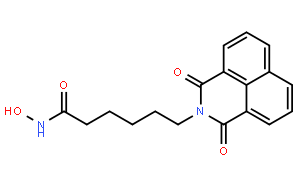| In vitro |
Scriptaid (6 μM) results in a >100-fold increase in histone acetylation in PANC-1 cell. Scriptaid (8 μM) is not lethal to PANC-1 cell and has limited effects (80% survival) on MDAMB-468. Scriptaid increases the transcription of pCMVb, p6SBE-luc and p6MBE-luc independent of a positive inducer of transcription. Scriptaid is capable of inducing high expression of p6MBE-luc, pCMVb, and pUB6/V5-LacZ, driven by viral (SV40 and CMV) or human (ubiquitin c, UB6) promoters, which do not depend on the specificity of the enhancer (SBE versus MBE), the type of promoter (viral versus cellular), the product of the reporter gene (luciferase versus b-gal), nor on the integration status of the reporter construct. [1]
Scriptaid induces high rates of somatic cell nuclear transfer (SCNT) oocytes development to the blastocyst stage and allowed full-term development (3.4, 4.2, 7.6, 6.8, and 4.1%) with all concentrations (50, 100, 250, 500, and 2000 nM respectively). Scriptaid improves the full-term development of cloned B6D2F1embryos in a dose-dependent manner with the maximum effect at 250 nM. Scriptaid enables the clone of all the important inbred mouse strains, such as C57BL/6, C3H/He, DBA/2, and 129/Sv. Scriptaid treatment enhances newly synthesized mRNA levels in cloned embryos. 250 nM Scriptaid treated for up to 48 h, does not inhibit the development of ICSI-fertilized embryos. [2]
Scriptaid inhibits T. gondii tachyzoite proliferation with IC50 of 39 nM. Scriptaid (0.225 μM) completely protects the HS68 monolayers from T. gondii tachyzoite. [3]
Scriptaid inhibits growth of ER negative cell lines, MDA-MB-231, MDA-MB-435 and Hs578t with IC50 of 0.5-1.0 μg/mL after 48 h treatment. 1 μg/ml Scriptaid treated for 48 h induces an accumulation of both acetylated H3 and acetylated H4 histone tail proteins, and a maximal of 20,000-fold increase of ER mRNA transcript. [4]
Scriptaid inhibits the proliferation and viability of the Ishikawa endometrial cancer cell line, and the SK-OV-3 ovarian cancer cell line with IC50 of 9 μM and 55 μM, respectively, while the normal human endometrial epithelial cells shows little sensitivity. Endometrial cancer cells and ovarian cancer cells cultured for 2 days in the presence of Scriptaid shows an accumulation in the G0/G1 phase (5 μM of Scriptaid) and G2/M phase (10 μM of Scriptaid) of the cell cycle, with a concomitant decrease in the proportion of those in the S phase. 10 μM of Scriptaid induces a 56.1% of apoptotic Ishikawa cells with loss of mitochondrial membrane potential, and decreased levels of cyclin A and bcl-2 levels by 50% and 20%, respectively. [5]
|

 COA
COA MSDS
MSDS HPLC
HPLC NMR
NMR